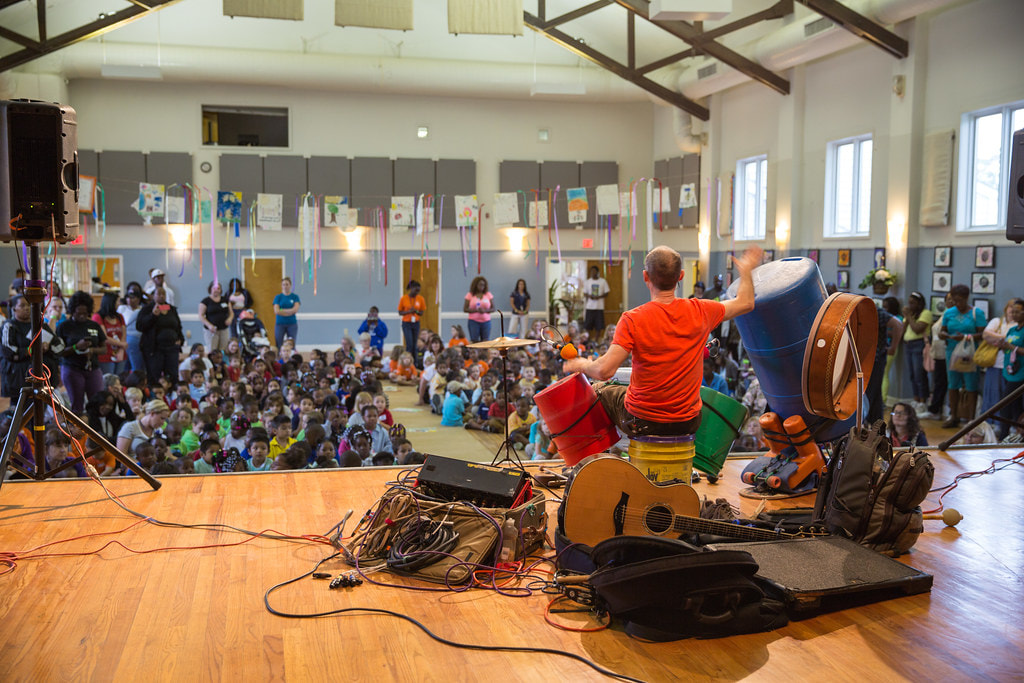To Participate or Not to Participate? Really, the Question is HOW to Participate!By ISJL Education Fellow Rena Lubin
Some folks may not have the greatest “cantor-level” singing voice, and that is okay. Some participants may not be able to keep a beat of their own, and that is alright. Some congregants may not be able to play guitar or any instrument for that matter, like Jewish rock star Geddy Lee from Rush (as hard as we may try). And while some members may shine in a song session, others may fade into the background. The question is: how can we not only increase participation but additionally make that participation alternative and accessible? Making Percussion a la Billy Jonas Jewish musician Billy Jonas is known for changing the game in music-making. His “funky family folk music” and “neo-tribal hootenanny” encourages active participation by any and all and consists of singalongs, bang-alongs, and percuss-alongs in which kids and adults learn their parts or make them up as they hear the music! There is no wrong answer, bad note, or poor ability when it comes to the making of music via Billy Jonas’ attitude. Jonas is all about showing that everyone can be a music innovator and that music can be made with nearly anything. Whether it is a hand hitting the knee, fingers snapping, a foot tapping rhythmically on the ground, car keys against a hip, repurposing an empty garbage can, or teaching simple hand movements to accompany the words of a song, anyone can be a Jewish musician! We can all emulate Jonas by looking at music as a creative, collaborative act. Creating Public Playlists One of the potentially inhibiting factors to increased participation during a song session is that folks do not know what that will entail. Participants are not often made aware ahead of time what songs will be sung, and therefore, they are unfamiliar with the content. The unknown can be wildly intimidating, especially if someone is not confident in their musical abilities! However, to make song sessions more enticing and accessible, educators and staff can try creating a public playlist either on YouTube or Spotify to share with congregants. This teaching tool should be completed with enough time before an event so that the community can familiarize themselves with the music! By making the setlist public, folks will not only be able to dispel a nervousness associated with not knowing what is to come, but families will have the ability to play and teach the music beforehand. The congregation can even promote the event by sharing the playlist on their social media, hyping people up for the event and hopefully enticing a larger audience! Expanding the Definition of Participation When we think of participating in a song session or musical performance, we often only think of singing or dancing… but those are not the only ways in which we can participate in the making, appreciation, and support of music in the Jewish community! We should expand what it means to participate; even if we offer alternative methods such as making up our own roles, lyrics, and instruments in an attempt to be as inclusive as possible, some congregants still may not want to classically “participate.” Let’s not discount all the preparation that goes into making a song session or event possible, the behind-the scenes planning and coordination that must be done to ensure a successful event. Let’s vocalize appreciation for the folks who may sit in the back, but still clap the loudest when a song has finished. Let’s acknowledge those who hum quietly to themselves or hesitantly tap their foot on the ground, for they are the backbone of a participatory audience. As we continue to serve students’ different learning styles, we should also be open to the creative ways in which we can engage more “musicians” of all ages! |
- Home
- WHO WE ARE
-
WHAT WE DO
- PODCAST
- Conference >
- Education >
-
CULTURE
>
- Culture Overview
- Cultural Programming >
-
History
>
-
Encyclopedia of Southern Jewish Communities
>
- Alabama Encyclopedia
- Arkansas Encyclopedia
- Georgia Encyclopedia
- Florida Encyclopedia
- Kentucky Encyclopedia
- Louisiana Encyclopedia
- Mississippi Encyclopedia
- North Carolina Encyclopedia
- Oklahoma Encyclopedia
- South Carolina Encyclopedia
- Tennessee Encyclopedia
- Texas Encyclopedia
- Virginia Encyclopedia
- Encyclopedia Credits
- Oral History
-
Encyclopedia of Southern Jewish Communities
>
- SPIRITUALITY >
- DONATE
- Shalom Y'all
- Strategic Plan
- Southern & Jewish Blog
- Calendar
- Virtual Press Kit
|
©2024 Goldring/Woldenberg Institute of Southern Jewish Life
|

